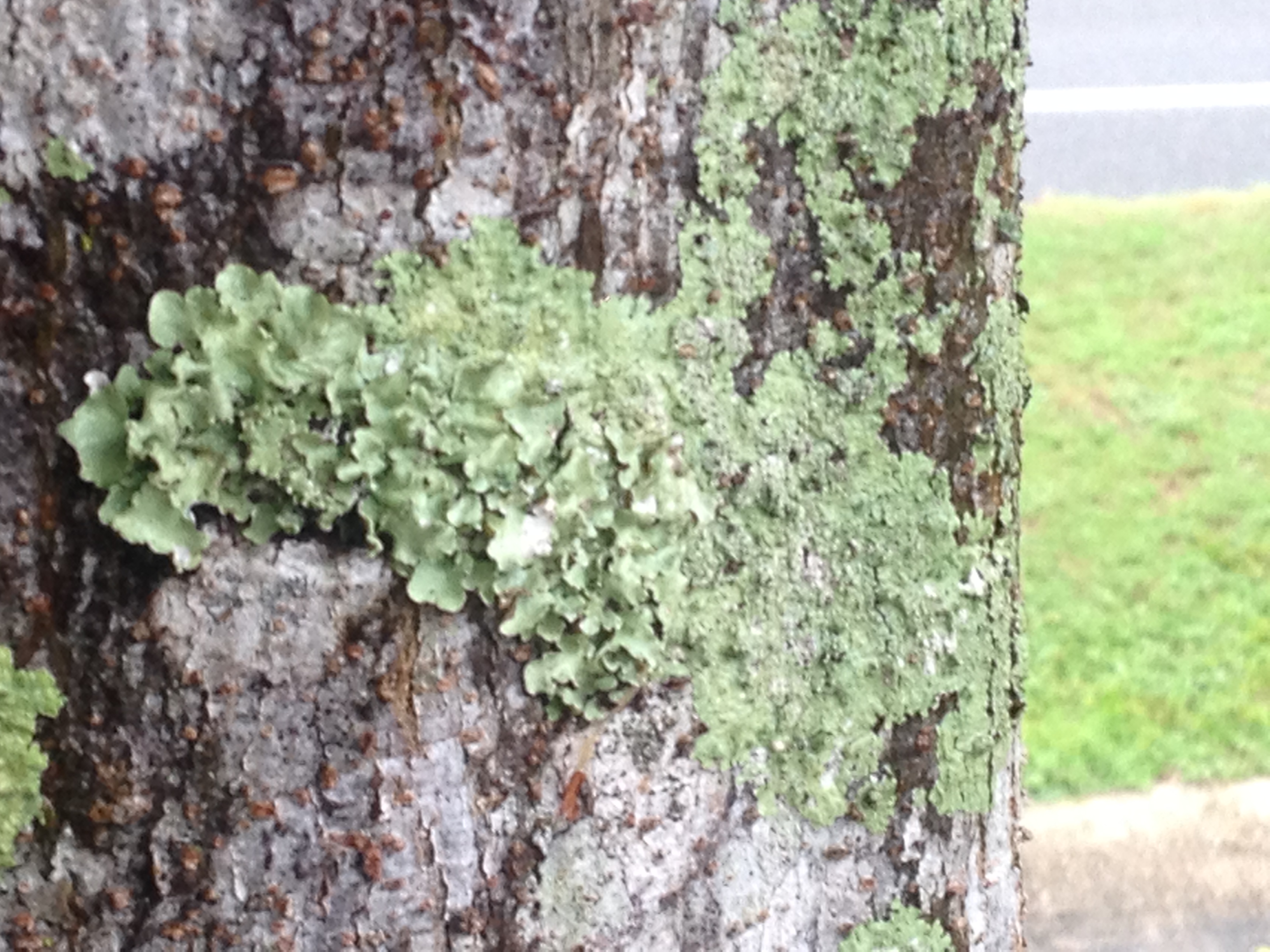
by Eddie Powell | Sep 9, 2014
Throughout the year I get calls asking about this mossy-like stuff growing on the bark of trees. For the most part, the calls are in the spring time when people have come out of winter hibernation and see their landscape plants covered with this alien figure. I am here to say that it is not an alien figure, though it may look like it is. These are lichens.
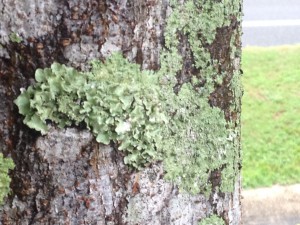
Photo Credit: Eddie Powell
Lichens often get mistaken for some unusual fungus that is killing trees. However, lichens are not single organisms, but rather a combination of two organisms that live together in a mutually beneficial way. There are over 20,000 different types of lichens found in nature. Lichens consist of a fungus and an algae; the fungus is more dependent upon its algae partner which produces enough food for both to survive. Lichens are very different from plants in that they can survive a complete body water loss. During this time, brittle pieces that flake off can later grow into new lichens. When moisture becomes available again, the lichen absorbs water and returns to its fleshy form.
The lichens growing on trees and shrubs are not parasites and do not harm the plants in any way. The lichens use the landscapes as a structure to become established.
There are four different forms of lichens found, crustose (crust-like, growing tight against the substrate), squamulose (tightly clustered and slightly flattened pebble-like units), foliose (leaf like, with flat sheets of tissue not tightly bound), and fruticose (free-standing branching tubes). Colors range from white to gray, green, red, yellow, and black. Lichens commonly found in our area are in the crustose, foliose, or fruticose form, and are white, gray, or gray-green in color.
Because lichens produce chemicals, they have very few natural predators. However, the most serious threat to lichens is air pollution. Most lichens will not grow in a polluted atmosphere and therefore you should be glad to see lichen here or there in your yard, as this is an indication that the air is relatively clean.
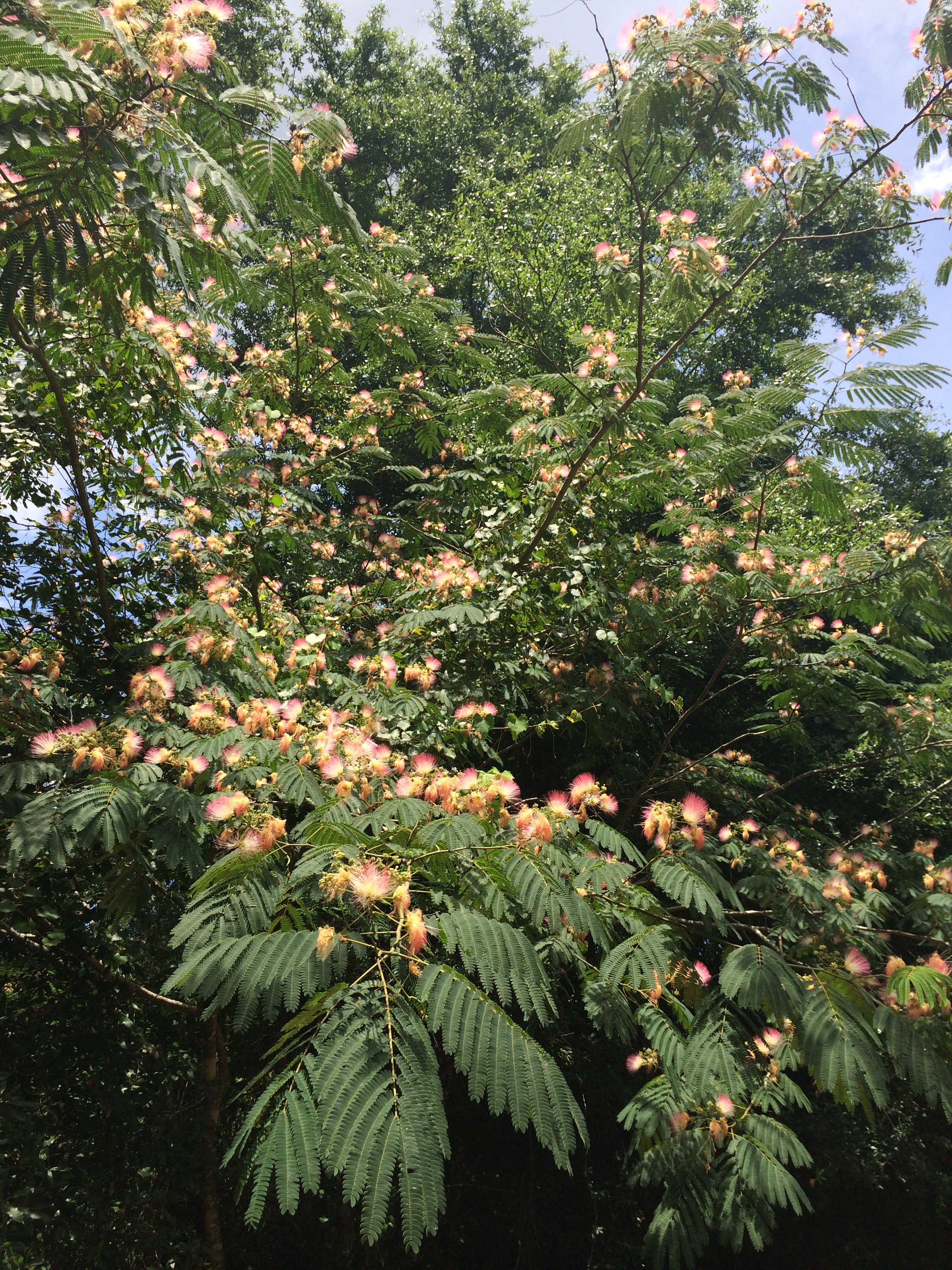
by Mary Salinas | Jun 10, 2014
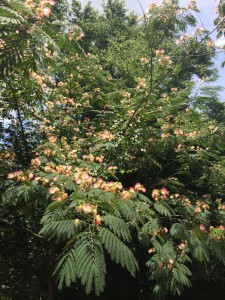
A mimosa tree invader in a natural area. Photo by Mary Derrick, UF IFAS.
All along the roadsides and in home landscapes this time of year, a profusion of fluffy pink blossoms are adorning trees known as Mimosa, or Albizia julibrissin. This native of China was introduced to home landscapes in this country in the 1700’s to enjoy the fragrant, showy flowers and fine, lacy foliage. However, there is a dark side to this lovely tree. After blooming, it produces an abundance of pods each containing 5 to 10 seeds. Seeds can be spread by wildlife and water; this is evidenced by the appearance of mimosa trees along the roadways, streams and in our natural areas. The seeds can also remain dormant for many years, allowing seedlings to keep sprouting up long after the mother tree is gone.
Mimosa has been categorized as an invasive exotic plant in Florida as it has not only naturalized, but is expanding on its own in Florida native plant communities. This expansion means that our native plants in natural areas get crowded out by the mimosa as it reproduces so prolifically.
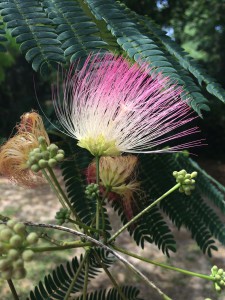
Bloom and foliage of the invasive mimosa tree. Photo by Mary Derrick, UF IFAS.
[important]The Florida Exotic Pest Plant Council (FLEPPC) publishes a list of non-native plants that have been determined to be invasive. Click here for the most recent 2013 list![/important]
The first step in controlling this pest plant is to remove existing plants in the landscape. Cutting it down at soil level and immediately painting the stump with a 25% solution of glyphosate or triclopyr should do the trick. Other details and control methods can be found here.
There are some native trees that make excellent alternatives to Mimosa such as fringe tree (Chionanthus virginicus), silverbell (Halesia carolina) and flowering dogwood (Cornus florida).
For more information:
Albizia julibrissin: Mimosa
UF IFAS Center for Aquatic and Invasive Plants: Mimosa
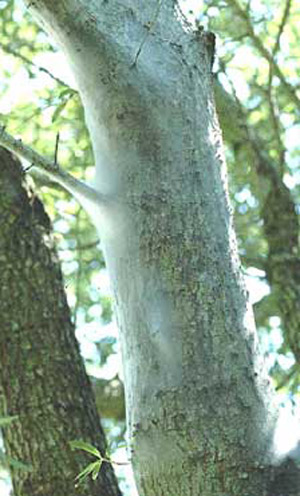
by Larry Williams | Jun 3, 2014
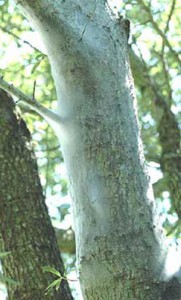
Glistening webbing formed by tree cattle (psocids) Photo credit: Doug Caldwell, University of Florida
Many people are noticing small insects on trunks and branches of their trees. When disturbed, these insects move in a group and are commonly called tree cattle because of this herding habit. They are ¼ inch brownish-black insects with white markings.
Some people assume that these insects will injure their trees but they are harmless. They could be considered beneficial.
These insects are called psocids (pronounced so-cids). They have numerous common names including tree cattle and bark lice. They feed on lichen, moss, algae, fungi, spores, pollen and the remains of other insects found on the tree’s bark. As a result, they are sometimes referred to as bark cleaners.
Tree cattle may form webbing. This webbing is tight against the tree’s trunk and/or limbs. It appears suddenly. The webbing is used as a protection from weather and predators. Underneath you may find psocids.
The glistening webbing may attract a person’s attention resulting in the tree being visually inspected from top to bottom. A dead branch or other imperfections in the tree may be noticed and then wrongly blamed on the tree cattle. I’ve talked to homeowners that sprayed their trees with insecticides or that hired pest control businesses to treat the trees as a result of finding the webbing/psocids. One person told me that he cut down a tree after finding tree cattle. He wrongly assumed that these insects were pests that might move through the area and kill trees. He thought he was doing a good thing.
Adult female psocids lay eggs in clusters on leaves, branches and tree trunks. After hatching, the immature insects (nymphs) remain together under their silk webbing. Adults have wings which are held roof-like over their body. Nymphs are wingless. Psocids usually have several generations per year in Florida.
After seeing the webbing and/or insects, many people insist on spraying insecticides because they believe these insec
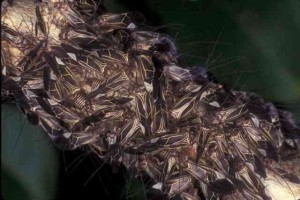
Under the webbing live hundreds of psocids. Photo credit: UF/IFAS Jim Castner
ts are damaging their trees. But as mentioned, they are bark cleaners and do not damage trees. If the silk webbing is considered unsightly, a heavy stream of water from a garden hose can be used to wash insects and webbing off infested trees. If nothing is done, the webbing usually goes away in several weeks.
Psocids can be found on many rough-barked hardwood trees and palms. Occasionally, they may be found on wood siding, fence posts or similar areas.
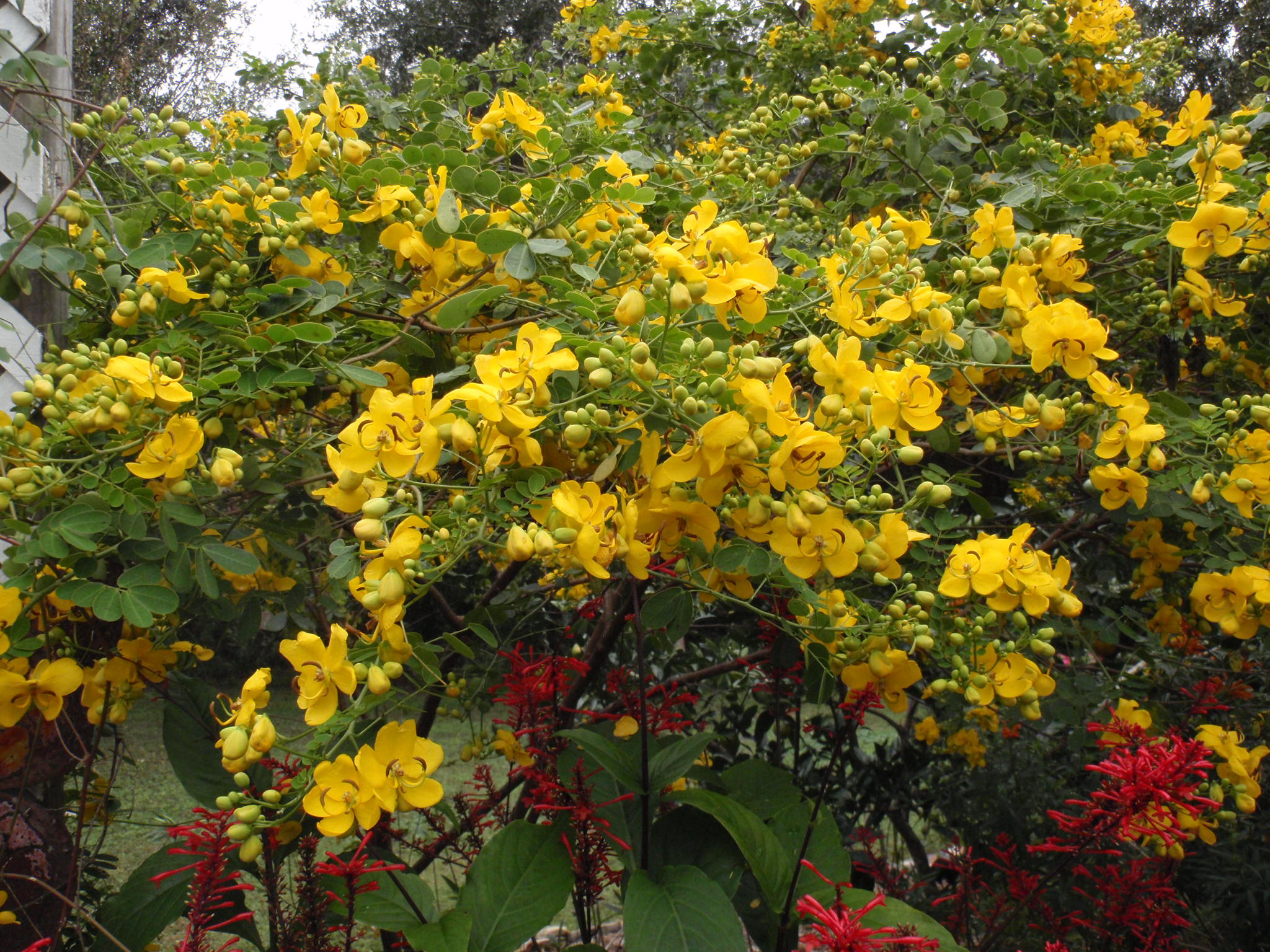
by Beth Bolles | Jan 14, 2014
Trees and shrubs often serve a distinct purpose in landscapes, other than to provide color. They are planted to provide shade, screen a view or noise, or to soften the hardscapes of the home.
With a little planning, we can have both beauty and function from trees and shrubs. Add a few trees and shrubs that have color in different seasons and your landscape will always be interesting.
The added benefit of growing trees and shrubs is that they are low maintenance. Once the plants are established in the landscape, they will require very little water and only an occasional application of a slow release fertilizer. A good layer of an organic mulch around the plants will help conserve moisture, prevent weeds, and keep root temperatures regulated during our temperature extremes. You may have to do a little pruning every year to remove any diseased, damaged, or severely crossing branches.
Here is a list of plants to give you garden interest throughout all seasons:
Winter color
- Taiwan cherry (Prunus campanulata) is an underutilized ornamental cherry for the coastal south. Clusters of dark pink flowers cover the plant which grows about 20 feet.
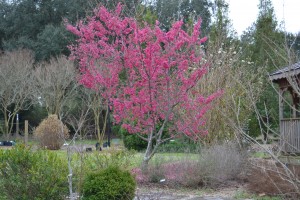
Taiwan cherry
- Camellia japonica is widely used in landscapes, but still an excellent choice for winter color. Careful selection of types will provide a garden with color from November through April.
- Red maple (Acer rubrum) will provide color in both the late winter and fall. Flowers are brilliant red in late winter and leaves begin turning red in late October.
- Other choices include Oakleaf hydrangea, Florida anise, Red buckeye, and Japanese magnolia
Spring
- Fringe tree (Chionanthus virginicus) can be in shrub or tree form and range in height from 10 – 20 feet. Forms white clusters of showy fringe-like flowers in late winter and early spring before the leaves emerge.
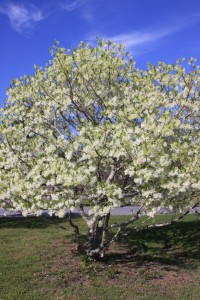
Fringe tree
- Chinese fringe (Lorepetalum chinesis ‘Rubrum’) is a very popular shrub. Pink blooms are heaviest in the spring. The plants can get up to 12 feet in height so plant it were it will not obstruct a view.
- Virginia sweetspire (Itea virginica) forms clusters of white flowers. Plants offer purplish foliage in the fall.
- Other choices include Banana shrub, native azaleas, Indian hawthorn, and Deutizia,
Summer
- Chaste tree (Vitex agnus castus) is a large shrub with fragrant leaves and spikes of purple flowers. Tolerates drought and develops interesting shape.
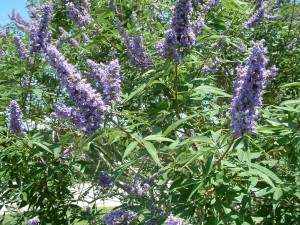
Chaste tree
- Loblolly bay (Gordonia lasianthus) is an evergreen tree that grows to 25-35 ft in height. Large white flowers with yellow stamens resemble camellia blooms.
- Abelia spp has white flowers that appear over the entire plant. It is attractive to butterflies .
- Other choices include Crape myrtle, Althea, Confederate rose, and Oleander
Fall
- Bald cypress (Taxodium distichum) will become a large tree over time. In the fall the feathery leaves will turn orange-brown. Good tree for both wet and dry areas.
- Beautyberry (Callicarpa americana) a native that forms clusters of purple berries that line the stem. Leaves turn yellow and provide fall interest as well.
- Cassia bicapsularis can reach 8-12 ft in height and will have bright yellow flowers that form in October and persist until a freeze.

Cassia
by Carrie Stevenson | Dec 9, 2013
How much is a 400-year old live oak tree worth? Can you buy one online, with free shipping, and charge it to the credit card? Pick one up at the local home improvement store? Ask Santa? Of course not. When admiring a tree that size, we have an innate sense of its value, but we would often have a hard time expressing it in dollars. How about a cluster of trees in a wooded lot? Are they worth more than the dollar store being built there? We are conditioned to appreciate the value of things because there’s a price tag on them. Unfortunately, natural phenomena do not have price tags, and many things that are “free” are often perceived to have no real value.
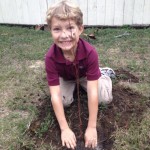
Planting a tree is an excellent way to insure clean air and water in the future. Photo credit: Carrie Stevenson
Trees, however, have value far beyond the price one might pay at a plant nursery. Their roots absorb polluted storm-water runoff, the primary cause of decreased water quality in Florida. Their leaves take in carbon dioxide and release the very oxygen we breathe. Providing homes for wildlife, fruit and nuts for human and animal consumption, compounds that form the basis of countless medications—trees provide innumerable benefits to ecosystems both local and worldwide. If a local government were to construct a facility or method that could filter the air and water at the same efficiency and volume of the trees in ones county, it would cost the community millions.
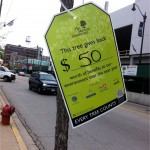
This street tree in Chicago was given a price tag to raise awareness of its value. Photo credit: Eric Stevenson
But how is is possible to capture these benefits in a way that we can relate to? Luckily, a partnership between arborists, engineers, and researchers with private industry, the US Forest Service, and the USDA has resulted in an excellent online tool called the National Tree Benefits calculator. Based on software called “i-Tree,” the calculator allows anyone to enter their zip code, choose from a list of common tree species, and using the diameter of a single tree, calculate its economic value. For example, a 15-inch live oak tree at the Escambia Extension office provides an annual benefit of $79 every year, increasing in value as it grows in girth and height. The website delves deeper into the tree’s value, placing storm-water uptake value at $23.77, electricity savings at $15.23, and the capability to remove 607 pounds of carbon dioxide from the atmosphere.
Extension Agents are currently working with youth in Escambia County to calculate these values for trees on their school campuses, local parks, and yards. When we’re finished, we will hang actual price tags on the trees showing their annual economic value to showcase these facts to residents of the community.
Interested in what kind of economic benefit that magnolia in the front yard is giving you? Check it out yourself at www.treebenefits.com, and let your neighbors know how valuable those trees can really be.















